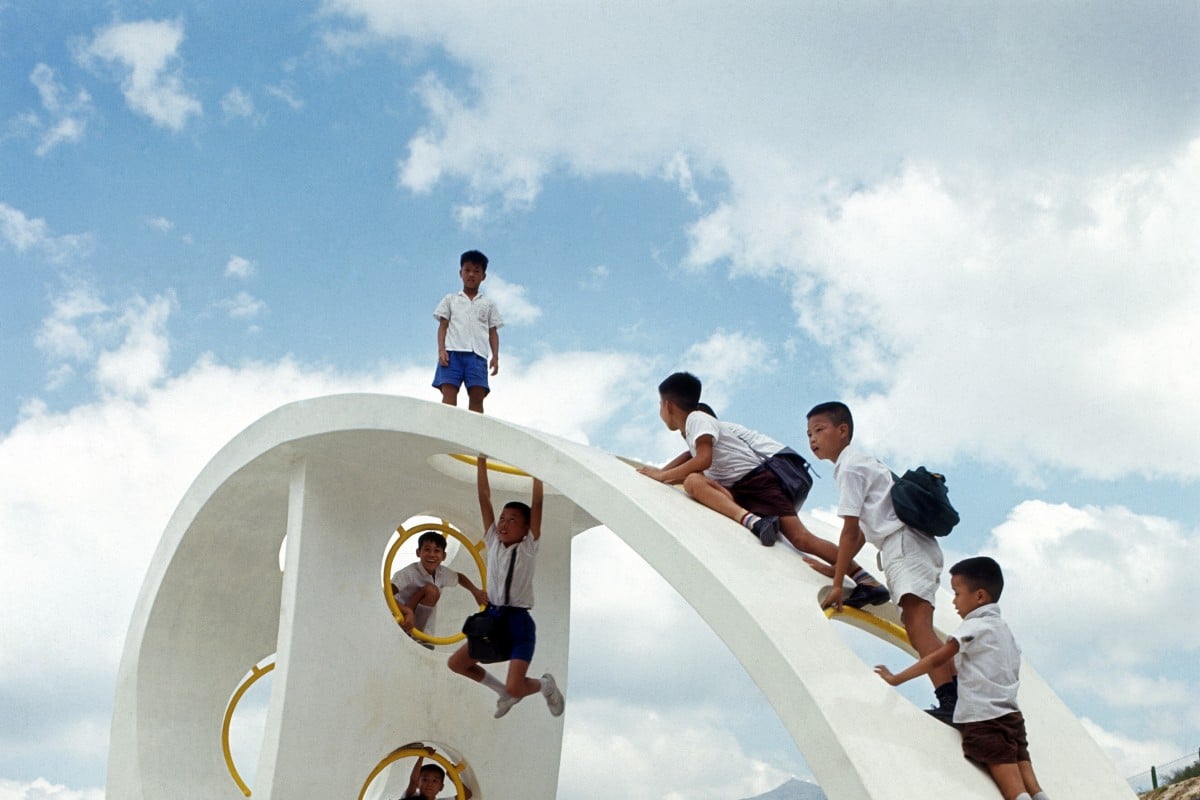
Swinging from past to future: The history and evolution of Hong Kong play areas, from Shek Lei Playground to WE Park
- The city’s play spaces need not be identical, but should inspire children and adults, says Helen Fan Lok-yi, author of ‘The Abstract Playscapes of Hong Kong’
- Every week, Talking Points gives you a worksheet to practise your reading comprehension with questions and exercises about the story we’ve written
 American artist Paul Selinger designed the now-demolished Shek Lei Playground, which was located in Kwai Chung. Photo: Information Services Department
American artist Paul Selinger designed the now-demolished Shek Lei Playground, which was located in Kwai Chung. Photo: Information Services DepartmentWhat is the most memorable playground you have ever visited? How would you improve the design of a play space if you had a say?
A typical children’s playground in Hong Kong often looks identical even across different districts. Its features are quite predictable – slides, swings and climbing frames.
These play spaces are safe for children and easy to maintain. But they have been criticised for being too monotonous and uninspiring in design – to the point that they fail to provide exciting elements to attract youngsters.
Check out Hong Kong’s scariest experience at Sugar Street Studio
This is why the voices of children – as playground users – should be heard in the design of play areas, according to Helen Fan Lok-yi, a Hong Kong curator and artist.
“The adults always lead the planning of a playground, and it is designed in a top-down approach that is easy to manage and that avoids complaints. But have they asked how the kids would want it to be?”
Fan’s recent book, The Abstract Playscapes of Hong Kong, is the first in the city to focus on its play spaces. The book suggests that the city’s playgrounds were not always so dull. Some 50 years ago was a “golden era” when designers created innovative equipment that inspired children to have fun.
Fan cited the iconic Shek Lei Playground in Kwai Chung in 1969 as an example. Designed by American artist Paul Selinger, the play space contained intriguing, abstract sculptures in bright colours, which is believed to have been the first of its kind in Asia.
The novel sculptures combined art and play, and aimed to inspire exploration and wonder as it had no rules or user manuals to follow. Everyone had their own way to play. Old pictures show children sliding down the sculptures, climbing up its sides, and going through its holes.
“We always thought children’s playgrounds meant a standard set of unappealing metal and plastic equipment installed over rubber safety floor mats,” Fan said. “But this shows it was not always the case.”
Skate back to the 1980s at Bun’s 2020
The park was demolished, likely between 1995 and 1997, according to Fan’s research into government records and park users’ oral accounts. There is no official documentation to show precisely when or why the park was taken down – or whether it was related to a redevelopment plan for Shek Lei Estate announced in 1985.
These findings inspired Fan to learn more about the history of Hong Kong’s playscapes. She contacted one of Selinger’s sons, Matthew, on Facebook. He found pictures from his dad’s time in Hong Kong and passed them to Fan, she said.
Fan’s recent book is part of her larger art project that calls for a fresh understanding of play spaces, which she believes are crucial to creating a better society.
Children’s playgrounds in Hong Kong were first built in the 60s and 70s when the city saw widespread poverty. They originated as a way for the government to keep poor children occupied, prevent youth crime and maintain public order, Fan said. Instead of appealing to young people’s creativity, it aimed to make them less disruptive and channel their energy in socially-acceptable ways.
Now, a child’s right to play is recognised as a crucial part of growing up. The Playright Children’s Play Association, founded in 1987, aims to promote and protect a child’s right to play and engage in recreational activities appropriate for their age. They believe play spaces should be enjoyable for adults too.
Playright collaborated with the Central and Western District Office to design a play space called WE Park, which opened in 2019. It is located in the Fung Mat Road Waterfront Open Space in Sai Ying Pun, and pays homage to Shek Lei Playground.
Look for this bright pink oasis in one of HK’s busiest neighbourhoods
The park uses large, recycled water pipes from Stonecutters Island. People can crawl through the pipes or slide down the ones that have been cut in half. These elements aim to empower users to play in creative ways.
Other parks are seeing a new look, too. In her 2019 Policy Address, Chief Executive Carrie Lam Cheng Yuet-ngor announced plans to modify more than 170 public play spaces under the Leisure and Cultural Services Department over the next five years. Most of these venues have standard play equipment that is easy to maintain and safe for users, but too dull and predictable in design.
“There is no set definition of the best playground,” Fan said. “Each generation has different demands and tastes in how to design a suitable playground. This is why the design process should be open-minded and engaging.”
Click here to download a printable worksheet with questions and exercises about this story. Answers are on the second page of the document.
